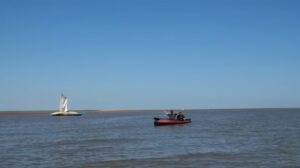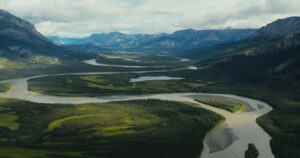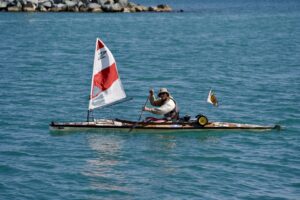The fabled Northwest Passage is changing as the world warms. The notoriously difficult arctic sea route that connects the Atlantic and the Pacific remains open for longer each year. This August, West Hansen, Jeff Wueste, Rebekah Feaster, and Jimmy Harvey are hoping to take advantage of the open water to kayak the 3,000km in a single season. If successful, they will be the first to kayak the entire Northwest Passage.

Three of the ‘Arctic Cowboys’, from left: Jimmy Harvey, West Hansen, and Jeff Wueste. Photo: West Hansen
The Arctic Cowboys
West Hansen, Jeff Wueste, and Jimmy Harvey have done expeditions together before. Wueste and Hansen completed the longest human-powered descent of the Amazon River and kayaked the Volga River. Harvey joined them for a Gulf Coast expedition, from Boca Chica at the Mexican border to Sabine Pass at the Louisiana border.
This will be Rebekah Feaster’s first expedition with the team, but she doesn’t lack experience. Feaster has completed eight Texas Water Safaris (a 420km boat race) and holds the record as the youngest woman to complete the race solo.
All four are from Texas, hence their team name, The Arctic Cowboys.

Rebekah Feaster. Photo: Rebekah Feaster
East-west or west-east?
The team will retrace the first successful crossing of the Passage, Roald Amundsen’s three-year odyssey that began in 1903. However, they have been debating whether to go east-west or west-east. The east-west route begins near Pond Inlet on northern Baffin Island. The west-east line starts from the town of Tuktoyaktuk on the western edge of the Passage.
“Both routes have their advantages and disadvantages,” Hansen told me. “The east-west route has the disadvantage of a later launch date because the entrance at Pond Inlet is located further north, with sea ice melting later in the year. The west-east route allows an earlier launch (Amundsen Gulf is further south and rarely engulfed in sea ice) but it leaves us with a great unknown regarding the ice conditions north of King William Island.”
Prior attempts to row and kayak the passage have come undone when starting from the west. Teams put in months of work only to encounter too much sea ice at around the two-thirds point. “I don’t want to be yet another kayak expedition that paddled from Tuk to Gjoa Haven, only to be blocked by ice,” said Hansen.
Instead, they will wait back in Texas, monitoring the ice, with a flexible schedule. The moment that the crux part of the Passage, on the east and west coasts of Somerset Island, looks doable, they will hurry north to Pond Inlet to begin.

Photo: West Hansen
The route
From Pond Inlet, the team will set off from Button Point, the southeastern point of Bylot Island and the eastern terminus of the Northwest Passage. Their route follows southern Lancaster Sound toward Somerset Island. This section also includes their longest open-ocean crossing, about 66km across Prince Regent Inlet between Baffin and Somerset Islands.
Once across the inlet, they will paddle south towards the Bellot Strait, a critical one-kilometre-wide, 30km long artery between southern Somerset Island and the Canadian mainland’s Boothia Peninsula.

Bellot Strait, looking west toward an ice blockage that some years, still stymies all vessels. Photo: Jerry Kobalenko
“It has a seven-knot tidal flow that reverses every four hours,” Hansen says. He doesn’t think they’ll be able to stop in the strait because of “rough rocky shores, fast-moving water, and a buttload of polar bears,” necessitating a single push through before the tide reverses.

Cliffs on Prince Leopold Island, Northwest Passage. Photo: Jerry Kobalenko
Once through Bellot Strait, they head south toward King William Island, crucial in the story of Sir John Franklin’s demise. Eventually, they cross to Victoria Island and resupply at the Inuit village of Cambridge Bay.
From here, they should have no further problems with ice, although they can expect rough seas in September as unstable autumn weather sets in. Hugging the south coast of Victoria Island, they’ll island-hop to the Canadian mainland, then follow the coast to their endpoint at Tuktoyaktuk. The town lies just east of the Mackenzie River delta and well past the point that Amundsen declared his journey through the Passage complete.
Why the Northwest Passage?
Hansen first became aware of the changing conditions in the Northwest Passage while reading Jon Waterman’s book Arctic Crossing. This led to him devouring other books on historic expeditions in the Passage, as well as media articles detailing the contemporary situation there.

The eastern terminus of the Northwest Passage, with Bylot Island barely visible on the southern horizon. Photo: Jerry Kobalenko
Like most shipping companies on the planet, Hansen concluded that the Northwest Passage is going to become an autobahn for supertankers and huge container ships. It shortens the Europe-Asia route significantly and reduces the importance of the Panama Canal.
“We want to experience and record this pristine 2,000-mile arctic archipelago while it’s still here,” says Hansen.
Smaller, faster kayaks
They will be paddling Epic 18 kayaks. These have less storage space than some sea kayaks but are lighter and faster. Their food will consist of the usual combination of dehydrated meals and high-energy snacks.
“Over the past several thousand miles of expeditions, we’ve honed our nutrition down quite well and take in nutrients almost constantly as we paddle, then really stuff ourselves in camp,” Hansen explained when running through their packing list.
Other essentials include a single large expedition tent and a shotgun plus flares to deter curious polar bears.

Camping out on a previous trip. Photo: West Hansen
Previous expedition experience has helped with other packing decisions too. They will wear two-piece dry suits, allowing a quick change depending on body temperature. “It can get pretty hot with too much clothing. We learned a lot while paddling in northern Russia in the ice, sleet, rain, and snow. It’s pretty easy to stay warm in a sea kayak.”
The team has budgeted 60 days for the expedition, factoring in that they could face a lot of downtime if the wind is uncooperative.






